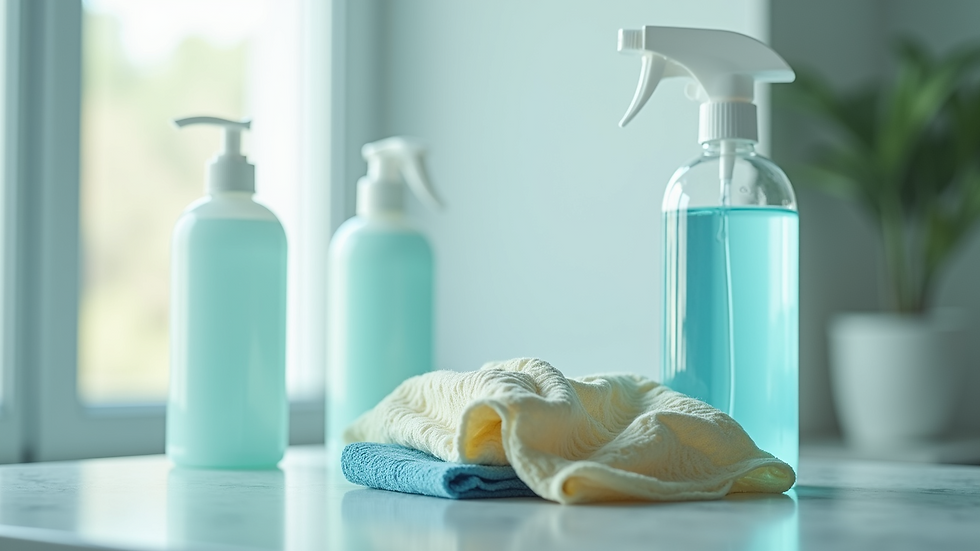Top Strategies for Effective Point-of-Use Cleaning
- peneworxtech

- Aug 26
- 3 min read
Maintaining cleanliness at the point of use is essential for ensuring hygiene, safety, and efficiency in various environments. Whether in healthcare, food service, or industrial settings, effective cleaning right where equipment or tools are used can prevent contamination and extend the life of valuable assets. This guide explores top strategies to optimize cleaning practices directly at the point of use, helping organizations maintain high standards with practical, actionable steps.
Understanding the Point-of-Use Cleaning Guide
Point-of-use cleaning refers to the process of cleaning equipment, tools, or surfaces immediately after use, before they are stored or moved to another location. This approach minimizes the risk of cross-contamination and buildup of dirt or pathogens. Implementing a robust point-of-use cleaning guide involves clear protocols, appropriate cleaning agents, and staff training.
Key Elements of an Effective Cleaning Guide
Clear Procedures: Step-by-step instructions tailored to specific equipment or surfaces.
Proper Tools: Use of microfiber cloths, disposable wipes, or brushes designed for the task.
Safe Cleaning Agents: Selection of disinfectants or detergents that are effective yet safe for the materials involved.
Regular Training: Ensuring all users understand and follow the cleaning protocols consistently.
Documentation: Keeping records of cleaning activities to monitor compliance and effectiveness.
By focusing on these elements, organizations can create a culture of cleanliness that supports safety and operational efficiency.

Best Practices for Implementing a Point-of-Use Cleaning Guide
To maximize the benefits of point-of-use cleaning, consider these best practices:
1. Immediate Cleaning After Use
Cleaning should occur as soon as possible after the equipment or surface has been used. This prevents the drying of contaminants, which can make cleaning more difficult and less effective.
2. Use of Appropriate Cleaning Agents
Select cleaning agents that are compatible with the materials being cleaned and effective against the expected contaminants. For example, in healthcare settings, EPA-registered disinfectants are often required.
3. Standardize Cleaning Tools
Use color-coded cloths or wipes to prevent cross-contamination between different areas or types of equipment. For instance, red cloths for restrooms and blue for general surfaces.
4. Train and Empower Staff
Regular training sessions and easy-to-follow guides empower staff to perform cleaning correctly. Visual aids and reminders at the point of use can reinforce good habits.
5. Monitor and Audit
Regular audits and feedback help maintain high standards. Use checklists and spot checks to ensure compliance and identify areas for improvement.
6. Incorporate Ergonomics
Design cleaning stations and workflows to minimize strain and improve efficiency. Easy access to cleaning supplies encourages consistent use.

What is a Safe Solution for Point of Use Cleaning?
Safety is paramount when selecting cleaning solutions for point-of-use applications. A safe solution should be effective against pathogens and contaminants while being non-toxic, non-corrosive, and environmentally friendly.
Characteristics of Safe Cleaning Solutions
Non-Toxic: Safe for users and the environment, with minimal harmful fumes.
Material Compatibility: Does not damage or degrade equipment surfaces.
Fast-Acting: Provides quick disinfection or cleaning to minimize downtime.
Residue-Free: Leaves no harmful residues that could affect subsequent use.
Regulatory Compliance: Meets local and industry-specific safety standards.
Examples of Safe Cleaning Solutions
Quaternary Ammonium Compounds: Widely used in healthcare for their broad-spectrum antimicrobial activity.
Hydrogen Peroxide-Based Cleaners: Effective and break down into water and oxygen, leaving no harmful residues.
Enzymatic Cleaners: Useful for breaking down organic matter without harsh chemicals.
Always follow manufacturer guidelines and safety data sheets when using cleaning products to ensure safe and effective use.

Integrating Technology to Enhance Point-of-Use Cleaning
Technology can play a significant role in improving the efficiency and effectiveness of point-of-use cleaning.
Digital Checklists and Reminders
Mobile apps and digital platforms can provide real-time checklists and reminders to staff, ensuring cleaning tasks are completed on schedule.
Automated Cleaning Devices
Robotic cleaners and UV-C light devices can supplement manual cleaning, especially in high-risk areas.
Data Analytics
Tracking cleaning frequency and outcomes through software helps identify trends and areas needing attention.
Training Simulations
Virtual reality (VR) and augmented reality (AR) tools can offer immersive training experiences, improving staff competence and confidence.
By embracing technology, organizations can streamline cleaning processes and maintain higher hygiene standards.
Tips for Sustaining Effective Point-of-Use Cleaning Practices
Maintaining consistent and effective cleaning at the point of use requires ongoing effort and commitment.
Regularly Update Protocols: Adapt cleaning guides based on new research, regulations, or equipment changes.
Encourage Feedback: Create channels for staff to report challenges or suggest improvements.
Recognize Good Performance: Incentivize adherence to cleaning protocols through rewards or recognition.
Maintain Supply Availability: Ensure cleaning materials are always stocked and easily accessible.
Promote a Clean Culture: Leadership should model and support cleanliness as a core value.
By embedding these tips into daily operations, organizations can sustain high standards and protect health and safety.
Implementing a comprehensive point of use cleaning strategy is essential for maintaining hygiene and operational efficiency. By following the strategies outlined in this guide, organizations can ensure that cleaning is effective, safe, and sustainable right where it matters most.



Comments